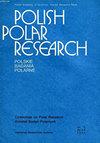叶绿素a荧光和DNA的变化作为植物对紫外- b辐射的响应
IF 0.8
4区 地球科学
Q4 ECOLOGY
引用次数: 0
摘要
本文章由计算机程序翻译,如有差异,请以英文原文为准。
Changes in Chlorophyll a fluorescence and DNA as a plant response to UV-B radiation in Gnaphalium vira-vira
: Ozone depletion at southern latitudes has recently increased the fluence of ultraviolet-B (UV-B) radiation striking the ground. This phenomenon has sparked much interest in unravelling the effects of this harmful radiation on living systems. UV-B radiation triggers several responses that affect plant physiology, morphology and biochemistry. In this study, the effect of supplemental UV-B radiation on DNA profile and chlorophyll a (CHl a ) fluorescence characteristics were analyzed. An increase in the genetic variability of irradiated plants was observed in the Inter Sequence Simple Repeats products. The effect on photosynthesis was studied through fluorescence emissions. The obtained data showed that photochemical quenching (qP) decreased in irradiated plants. This effect may be attributed to a decrease in the number of open reaction centers of photosystem II (PSII) as suggested by the decreased values of minimal and maximal fluorescence. Likewise, non-photochemical quenching (NPQ) increased in both control and irradiated groups, but treated plants presented lower NPQ values than controls. The heat dissipation mechanism was also altered, probably due to a decrease i in the yield of the maximal fluorescence in light-adapted leaves (Fm´). According to these findings, UV-B radiation affects the CHl a fluorescence mechanisms and modifies
求助全文
通过发布文献求助,成功后即可免费获取论文全文。
去求助
来源期刊

Polish Polar Research
ECOLOGY-GEOSCIENCES, MULTIDISCIPLINARY
CiteScore
2.00
自引率
7.70%
发文量
0
审稿时长
>12 weeks
期刊介绍:
The quarterly Polish Polar Research edited by the Committee on Polar Research of the Polish Academy of Sciences is an international journal publishing original research articles presenting the results of studies carried out in polar regions.
All papers are peer-reviewed and published in English.
The Editorial Advisory Board includes renowned scientist from Poland and from abroad.
 求助内容:
求助内容: 应助结果提醒方式:
应助结果提醒方式:


